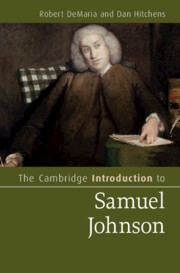Book contents
- The Cambridge Introduction to Samuel Johnson
- The Cambridge Introduction to Samuel Johnson
- Copyright page
- Dedication
- Contents
- Figures
- Acknowledgements
- Chronology
- Abbreviations
- Chapter 1 Life and Times
- Chapter 2 Journalist
- Chapter 3 Poet and Storyteller
- Chapter 4 Scholar
- Chapter 5 Critic
- Chapter 6 Social and Political Thinker
- Chapter 7 Biographer
- Chapter 8 Legend
- Notes
- Further Reading
- Index
- Cambridge Introductions to Literature
Chapter 3 - Poet and Storyteller
Published online by Cambridge University Press: 07 February 2025
- The Cambridge Introduction to Samuel Johnson
- The Cambridge Introduction to Samuel Johnson
- Copyright page
- Dedication
- Contents
- Figures
- Acknowledgements
- Chronology
- Abbreviations
- Chapter 1 Life and Times
- Chapter 2 Journalist
- Chapter 3 Poet and Storyteller
- Chapter 4 Scholar
- Chapter 5 Critic
- Chapter 6 Social and Political Thinker
- Chapter 7 Biographer
- Chapter 8 Legend
- Notes
- Further Reading
- Index
- Cambridge Introductions to Literature
Summary
While most of Johnson’s paid professional writing was in prose, he wrote accomplished poetry from the age of 15 until the last month of his life, and often poured into it his most personal feelings – especially those poems and verse prayers which he wrote in Latin. Most celebrated are Johnson’s two imitations of satires by Juvenal. In London, the first of these, Johnson adopted the light personification (‘unrewarded science toils in vain’) which became his trademark. The second, The Vanity of Human Wishes, is the quintessential Johnsonian work, a meditation on false hope whose conclusion can be read as either tragic or optimistic. The same theme runs through Johnson’s fictional writing – the shorter tales as well as his longest, Rasselas. This gently comic work, much of it merely episodic, follows the Abyssinian Prince, Rasselas, as he seeks the answer to life – and ends on another ambiguous conclusion.
- Type
- Chapter
- Information
- The Cambridge Introduction to Samuel Johnson , pp. 42 - 60Publisher: Cambridge University PressPrint publication year: 2025

